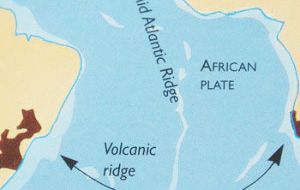MercoPress. South Atlantic News Agency
Mid-Atlantic ridge with iron-rich waters extending from Brazil to Namibia discovered
 The iron plume may provide a great nutrient attraction for phytoplankton, the base of many marine food webs
The iron plume may provide a great nutrient attraction for phytoplankton, the base of many marine food webs At the slow-spreading mid-Atlantic ridge in the South Atlantic Ocean an iron cloud spreads for more than 1,000 kilometers across the Atlantic from west of Namibia, Africa, to northeast of Rio de Janeiro, Brazil. The iron-rich waters flow 1,500 to 3,500 meters beneath the surface of the ocean. The complete extent and shape of the iron plume remains to be discovered.
“We had never seen anything like it,” said Mak Saito, Woods Hole Oceanographic Institute scientist and lead author of the study.” “We were sort of shocked—there’s this huge bull’s-eye right in the middle of the South Atlantic Ocean. We didn’t quite know what to do with it, because it went contrary to a lot of our expectations.”
Hydrothermal vents, on the ocean floor are responsible for releasing the iron but the type of vent came as a surprise to the WHOI and University of Liverpool oceanographers who discovered it. The slow-spreading Atlantic ridge was thought to produce less iron and other chemicals than vents in regions with ridges that spread at a quicker pace, like the ridge in the eastern Pacific.
“This study and other studies like it are going to force the scientific community to reevaluate how much iron is really being contributed by hydrothermal vents and to increase those estimates, and that has implications for not only iron geochemistry but a number of other disciplines as well,” said Saito.
The mid-Atlantic iron plume may provide a great nutrient attraction for phytoplankton, which form the base of many marine food webs by providing food for fish and whales. The plankton also suck in large amounts of carbon dioxide. Low levels of the micronutrient iron limit primary production and nitrogen fixation in large areas of the global ocean. The location and magnitude of oceanic iron sources remain uncertain, however, owing to a scarcity of data, particularly in the deep ocean. Although deep-sea hydrothermal vents along fast-spreading ridges have been identified as important contributors to the oceanic iron inventory, slow-spreading ridges, which contribute more than half of the submarine ridge-crest environment, were assumed to be less significant.
The measurements of dissolved iron and manganese concentrations made by Mak Saito’s team, along a full-depth section in the South Atlantic Ocean, running from offshore of Brazil to Namibia detected a large dissolved iron- and manganese-rich plume over the slow-spreading southern Mid-Atlantic Ridge. Using previously collected measurements of helium-3 concentrations (a tracer of hydrothermal activity), they calculate the ratio of dissolved iron to hydrothermal helium in the plume waters and found that it is around eighty times higher than that reported for plume waters emanating from faster-spreading ridges in the southeastern Pacific. Only the application of a higher ratio in global ocean model simulations yields iron fluxes from these slow-spreading submarine ridges that are in line with their observations.
The researchers are suggesting that global iron contributions from hydrothermal vents are significantly higher than previously thought, owing to a greater contribution from slow-spreading regions. These finds are very likely to lead to a strong increase in mid-Atlantic ridge research involving a variety of research fields in the near future.




Top Comments
Disclaimer & comment rules-

-

-

Read all commentsI trust that everybody has noted the position of Tristan da Cunha. Part of the BRITISH OVERSEAS TERRITORY of Saint Helena, Ascension and Tristan da Cunha. Anyone interested should note that Tristan is 1,866 miles from Walvis Bay in Namibia and well beyond the Namibian shelf. In South America, Montevideo is 2,436 miles away. So, if it's valuable, it's BRITISH. And it's within an undersea ridge. So the ridge is British. African and Latam states can stay away unless they have licences. No longer international waters.
Nov 11th, 2013 - 05:11 pm 0Comment removed by the editor.
Nov 11th, 2013 - 06:43 pm 0@2 Your remark HAS been reported. Perhaps you'd like to die every time you come out with a comment to which you have no answer. Do yourself a favour and go back to doing what you “might” be good for. Dragging your arse down a gravel path.
Nov 11th, 2013 - 07:14 pm 0Commenting for this story is now closed.
If you have a Facebook account, become a fan and comment on our Facebook Page!